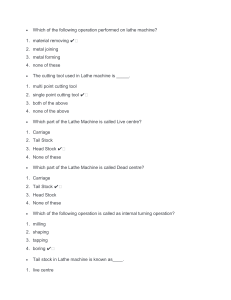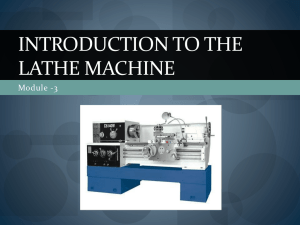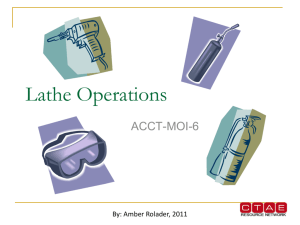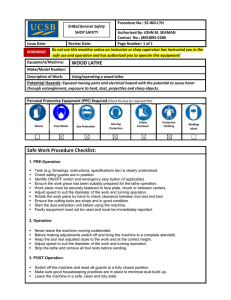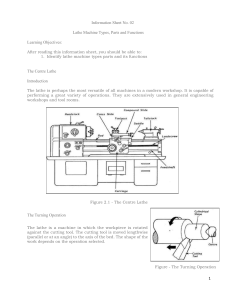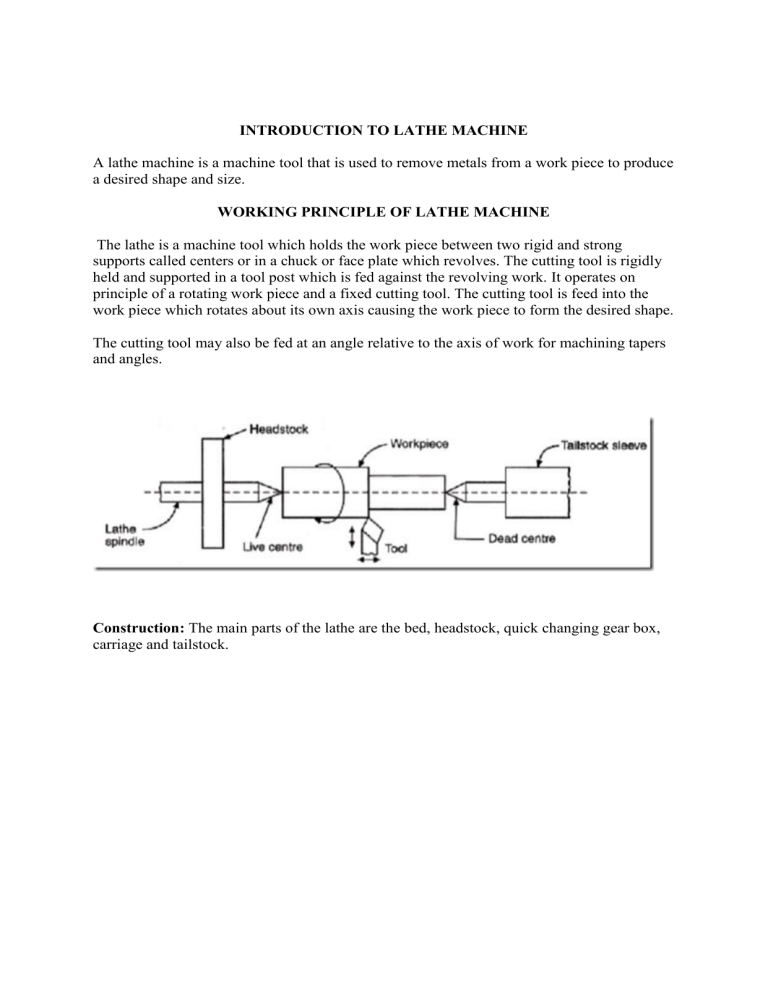
INTRODUCTION TO LATHE MACHINE A lathe machine is a machine tool that is used to remove metals from a work piece to produce a desired shape and size. WORKING PRINCIPLE OF LATHE MACHINE The lathe is a machine tool which holds the work piece between two rigid and strong supports called centers or in a chuck or face plate which revolves. The cutting tool is rigidly held and supported in a tool post which is fed against the revolving work. It operates on principle of a rotating work piece and a fixed cutting tool. The cutting tool is feed into the work piece which rotates about its own axis causing the work piece to form the desired shape. The cutting tool may also be fed at an angle relative to the axis of work for machining tapers and angles. Construction: The main parts of the lathe are the bed, headstock, quick changing gear box, carriage and tailstock. 1. Bed: The bed is a heavy, rugged casting in which are mounted the working parts of the lathe. It carries the headstock and tail stock for supporting the workpiece and provides a base for the movement of carriage assembly which carries the tool. 2. Legs: The legs carry the entire load of machine and are firmly secured to floor by foundation bolts. 3. Headstock: The headstock is clamped on the left hand side of the bed and it serves as housing for the driving pulleys, back gears, headstock spindle, live centre and the feed reverse gear. The headstock spindle is a hollow cylindrical shaft that provides a drive from the motor to work holding devices. 4. Gear Box: The quick-change gear-box is placed below the headstock and contains a number of different sized gears. 5. Carriage: The carriage is located between the headstock and tailstock and serves the purpose of supporting, guiding and feeding the tool against the job during operation. The main parts of carriage are: a) The saddle is an H-shaped casting mounted on the top of lathe ways. It provides support to cross-slide, compound rest and tool post. b) The cross slide is mounted on the top of saddle, and it provides a mounted or automatic cross movement for the cutting tool. c) The compound rest is fitted on the top of cross slide and is used to support the tool post and the cutting tool. d) The tool post is mounted on the compound rest, and it rigidly clamps the cutting tool or tool holder at the proper height relative to the work center line. e) The apron is fastened to the saddle and it houses the gears, clutches and levers required to move the carriage or cross slide. 6. Tailstock: The tailstock is a movable casting located opposite the headstock on the ways of the bed. The tailstock can slide along the bed to accommodate different lengths of workpiece between the centers. A tailstock clamp is provided to lock the tailstock at any desired position. The tailstock spindle has an internal taper to hold the dead centre and the tapered shank tools such as reamers and drills. LATHE OPERATIONS The engine lathe is an accurate and versatile machine on which many operations can be performed. These operations are: 1. Facing It is the first operation that is done on the work piece. It is a machining operation which is done to produce flat surfaces at the ends of the work piece. This operation is performed by feeding the tool perpendicular to the axis of rotation of the chuck. 2. Turning In turning operation, the excess material is removed from the surface of the work piece to produce a cylindrical surface of desired shape and size. During the turning operation, the feed is moved along the axis of rotation of the chuck. It reduces the diameter of the cylindrical work piece. Plain Turning: Plain turning is the operation of removing excess amount of material from the entire surface of a cylindrical job. Step Turning: Step turning produces various steps of different diameters. 3. Parting off The parting off or cutting off is the operation of cutting away a desired length of the workpiece, i.e., dividing the workpiece in two or more parts after it has been machined to the required shape and size. 4. Drilling It is the process of making holes in the work piece by use of drills. The drill is held in the tailstock and the drilling operation is done by advancing the drill in the work piece by rotating the hand wheel on the tailstock. 5. Reaming The holes that are produced by drilling are rarely straight and cylindrical in form. The reaming operation finishes and sizes the hole already drilled into the workpiece. 6. Boring The boring operation is the process of enlarging a hole already produced by drilling. 7. Knurling The knurling is a process of embossing (impressing) a diamond-shaped or straight-line pattern into the surface of workpiece. Knurling is essentially a roughening of the surface and is done to provide a better gripping surface. 8. Grooving Grooving is the process of creating a narrow slot on the work piece. It is also known as recessing or necking. 9. Threading Threading is the act of cutting of the required form of threads on the internal or external cylindrical surfaces. 10. Forming It is the process in which a convex, concave or any irregular surface is formed on the work piece with the help of a forming tool. Forming tool having the required shape is used to perform forming operation. 11. Chamfering Chamfering is the process of beveling the extreme ends of a work piece. It is done in order to remove the burrs, to protect the end of the work piece from being damaged and to make a better look. Chamfering can be done by a form tool having angle equal to chamfer which is generally kept at 45°. 12. Filing and Polishing The filing or polishing is the finishing operation that removes burrs, sharp corners and feed marks from the workpiece. After filing, the surface quality of the work piece is improved by the polishing operation with the help of emery cloth of fine grades. 13. Taper turning The taper turning is an operation of producing a conical surface by gradual reduction in the diameter of a cylindrical work piece. During taper turning the feed is set at an angle to the work piece. SPECIFICATION OF LATHE MACHINE A lathe is generally specified by: 1. Swing or the largest diameter of work that can be swung over the lathe bed. 2. The distance between the headstock and tailstock center. 3. Length of lathe, which include headstock length. 4. Width of the bed. 5. The pitch of the lead screw. 6. Horse power of the machine. 7. Speed range and the number of speed of the spindle. 8. The weight of the machine in tonne. 9. Maximum diameter of the work that can pass through the spindle or collet chuck. 10. Size of the tool post.
